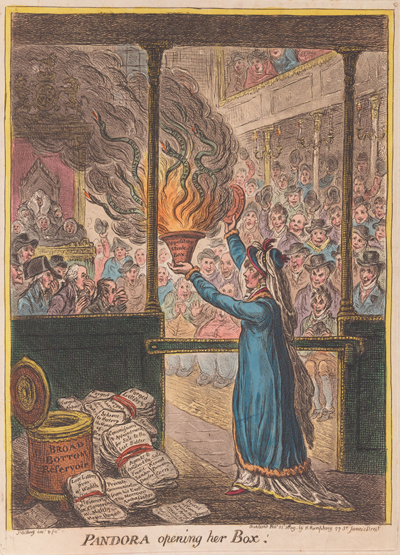Pandora Opening her Box
Pandora is a mythological figure blamed, like Eve in Christianity, for unleashing evil into the world. In Pandora's case this is supposed to have occurred as a result of opening a pithos (a jar or vessel mistranslated as a box) which she was expressly forbidden to open. When, predictably, her curiosity got the better of her, all the evils of a post-lapsarian existence which had been stored up in the vessel were now released into the world.
In Gillray's print Pandora is Mary Anne Clarke, from 1803 to 1806 the mistress of Frederick, Duke of York, the favorite son of King George and the head of the British army. Not satisfied with being supported as his mistress in a royal style to which she was certainly unaccustomed, Mrs. Clarke supplemented their income by selling military commissions and ecclesisastical preferments to place-seekers, using her influence with Frederick to make sure they happened.

© Yale University Library
In May of 1806, because of her general and seemingly careless extravagance, the Prince broke off relations with her, buying her silence (at least temporarily) by settling an annual pension of £400 on her until 1808. But when he failed to renew the pension, she threatened, and ultimately made good on her threat, to lift the lid on their relationship, correspondence, and transactions. The Prince may have assumed that no one would believe her, but her insinuations (bolstered by the assertion of Captain Denis Hogan that he had been passed over for a promotion because he refused to meet Mrs. Clarke's demands) provoked a full Parliamentary investigation, led by a radical MP, Gwyllym Lloyd Wardle, ostensibly in the name of military reform. Mrs. Clarke herself testified as part of the proceedings, apparently dressed much as she appears in Gillray's print.
In an early and surprisingly one-sided view of the case, Gillray portrays the resulting "stink" of Mrs. Clarke's "revelations" as basically groundless and politically and personally motivated. The jar held up before the assembled members is pointedly labeled "Opposition Stink Box." The viperous snakes writhing their way out of it are tagged (somewhat redundantly) as "Lies," "Deceit," "Perjury," and "Calumny," with two other snakes representing the motives of the lies as "Ingratitude" and "Revenge." Not surprisingly, the ministerial side of the House is holding their noses, while the Opposition members are enjoying the political theatre of blatant corruption in the military and the humiliation of the Duke by the witty and articulate Mrs. Clarke.
The papers on the floor are labeled to reflect some of the details of the allegations, including "Prices of Commissions in the Army," "Commissions & Appointments for Sale to the best Bidder," and a list of "Agents to conduct the Sale—Frome, Sanden, Dowler, Kennet, Donnovan, Corri." But the theme of forgery and political character assasination is hammered home in labeled notes such as "Forged Letters & Forged Answers from the Duke;" "Forged Orders," "Forged Appoint[ments]" and "Scheme to Destroy the House of Brunswick." Finally, next to these bundles is a close stool tagged "Broad Bottom Reservoir" suggesting that a further supply of what is deemed to be excrement can be expected from the defunct Ministry of All the Talents which had ended in March 31, 1807.
In the end, there were no real winners. The reputation of the Duke was significantly tarnished and he was forced to resign his position as head of the army. Wardle's credibility as a disinterseted reformer was severely compromised when it was revealed that he was also Mrs. Clarke's lover. And Mrs Clarke herself was tried and convicted in 1813 for libel though interestingly not for her two "tell-all" books about the Duke, but for remarks about the Irish Chancellor of the Exchequer in A Letter to the Right Hon. William Fitzgerald.
Sources and Reading
- Commentary from the British Museum on Pandora Opening her Box.
- Draper Hill, The Satirical Etchings of James Gillray, 1976, #94.
- "Pandora," Wikipedia
- "Mary Anne Clarke," Wikipedia
- "The Duke of York Scandal, 1809," The History of Parliament
- "Prince Frederick, Duke of York and Albany," Wikipedia
- Gwyllym Lloyd Wardle Mold & District Civic Society
- Thomas Wright and R.H. Evans, Historical and Descriptive Account of the Caricatures of James Gillray #352.
- Thomas Wright and Joseph Grego, The Works of James Gillray, the Caricaturist; With the History of His Life and Times, p. 362.
Comments & Corrections
NOTE: Comments and/or corrections are always appreciated. To make that easier, I have included a form below that you can use. I promise never to share any of the info provided without your express permission.